|
Naval SEa Air and Land commandos have a
legendary reputation for aggressive action in pursuit of their
stated goal or mission. Tenacity and single-mindedness are
their stock in trade. If we keep this in mind, it should
come as no surprise that one of the most successful tactical
gear brands should be headed by a member of this legendary
fraternity.
Mike Noell, President and CEO of BLACKHAWK
Products Group, served several years with Naval Special
Warfare in North Africa and the Middle East. Company
literature attributes the genesis of the Blackhawk brand concept
with a failed backpack which dropped from Mike’s shoulders and
landed in the middle of a minefield. He vowed then to
create products worthy of a soldier’s trust and the company
was born in 1993. Since 2003, Blackhawk has gone on a
voracious acquisition spree, in the process morphing into the
Blackhawk Products Group. This umbrella organization now
encompasses lines of product as diverse as backpacks, boots,
clothes, flashlights, gloves, hydration packs, knives, SWAT
entry tools, and - the point of this article – holsters.
Within Blackhawk Products Group, holsters fall
under the Close Quarters Combat© brand name. They
produce several lines of holsters; this article will deal with
the traditional leather line and a line of thermoplastic
holsters featuring their patented SERPA© Active Retention
system.
In the leather line, I chose a traditional
favorite called the Compact Askins, ordering it for my Beretta
92FS. Being of reduced stature (Napoleon could have looked
down on me), I felt I had given Blackhawk a daunting challenge,
namely to hide the big Italian on my minimal frame. The
holster arrived in short order and proved equal to the
challenge. Unlike other Avenger-style holsters I have
handled, the CQC© model has a slight muzzle-rear cant.
Coupled with the trailing belt slot, the cant serves to place
the butt against the good old latissimus dorsi. The
appropriate cover garment will have no trouble hiding the weapon
unless the wearer chooses to engage in spontaneous toe touches.
The quality of the holster is readily apparent upon first
review. Made in the Tuscany region of Italy, the product
has a smooth, even finish with quality hand-stitching, doubled
in the areas necessary to promote longevity and strength.
A sewn-in sight track flared slightly at the bottom prevents the
Beretta’s shark-fin front sight from hanging during the draw.
A hex-head tension screw allows the wearer to fine tune the
retention provided by its gun-specific boning.
The second holster I tried represents the sharp
tip of the Blackhawk spear. For my GLOCK 17, I
chose the CQC© Carbon-Fiber model with Blackhawk’s patented
Serpa retention system. It represents the first design of
which I am aware that disengages via the index finger. The
release button is positioned so that the finger falls onto the
frame, not the trigger, as the gun is withdrawn from the
holster. The draw stroke is streamlined, allowing a full
firing grip while the gun is still locked in the holster.
A simple press inward of the lock releases the gun as the grip
is established. While maintaining pressure on the lock,
the shooter simply pulls upward on the frontstrap of the weapon.
The index finger “wipes” upward until the gun is clear at
which point it falls into the ready position on the frame.
A very few draws ingrains the stroke in the mind. Unlike a
traditional thumb-break, the release of the retention device
does not mandate a repositioning of the thumb to maintain full
control of the weapon during the draw. From a retention
standpoint, the holster does not immediately announce its
release mechanism to the average gun-grabbing felon and must be
studied closely to be defeated. From a right-handed
adversary’s standpoint, the holster is impossible to release
from a face-to-face grab.
The holster features the light weight of most
polymer designs and comes with two mounting platforms, a
traditional set of belt loops and a paddle. A trio of
screws attaches either platform to the basic holster and can be
positioned so as to allow the holster to be worn muzzle forward,
muzzle to the rear, neutral cant, or crossdraw. A pair of
belt slot adjustment tabs allows for the use of several size
belts and the ability to adjust the ride height of the holster.
The polymer design seems thinner than most while maintaining
enough rigidity for good support. The novel retention
release allows the design to be loose enough to eliminate any
drag during the draw. Only two minor points keep me from
gushing unprofessionally. With a butt heavy design like my
GLOCK 17, the butt tends to bounce a bit under vigorous
movement. And the grip of the paddle on the belt
seems a bit tenuous. I would like to see Blackhawk take
another look at the flanges on the holster and paddle and
perhaps give them a more aggressive profile, allow them to bite
a bit harder. No other paddle I own releases for removal
as easily as this design, and several times I have thought the
paddle was firmly seated only to draw it out with the gun.
As I continued to use the holster, I learned to manipulate the
flanges to grip the belt so it happens rarely now, but it is a
point that could stand improvement.
Unlike many companies, Blackhawk refuses to cast
aside the traditional designs, yet they are unafraid to
innovate, to revolutionize. I get the feeling, shooters in
2050 will be looking back at the designs Blackhawk produces
today as the new classics.
Matthew Wellington
Read more about
Matt on the
"About Us" page.
  
Got something to say about this article? Want to agree (or
disagree) with it? Click the following link to go to the GUNBlast Feedback Page.
|
|
Click pictures for a larger version.

Blackhawk caters to fans of the old and the new with
their lines of holsters.
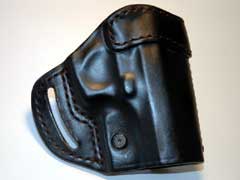
The Compact Askins features fine boning, tension
adjustment, and a reinforcing band to assist reholstering.
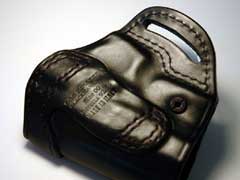
The trailing slot tucks the butt in to minimize printing
and double-stitching increases durability.
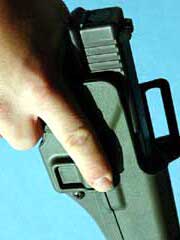
The latch must be pressed to release and held as the gun
is withdrawn upward.
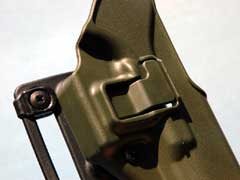
Here is the latch in the locked position…..
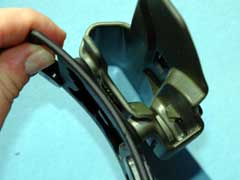
...and
an interior view showing the tab which protrudes into the
forward portion of the trigger guard.
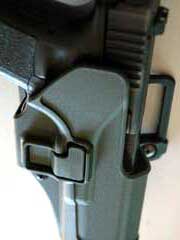
The novel retention method allows a loose enough fit for
easy withdrawal and the front is cut low. The draw is
very quick and relatively effortless.
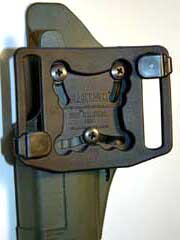
The retaining screws may be removed to replace the belt
slot with a supplied paddle or to adjust the cant to neutral,
FBI, or crossdraw. The tabs present in the slots can
also be used to cant the rig and to position the holster
higher or lower on the belt.
|
![]()